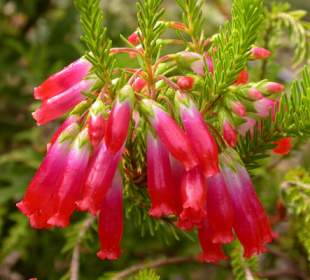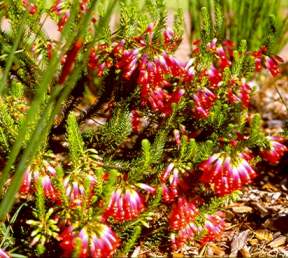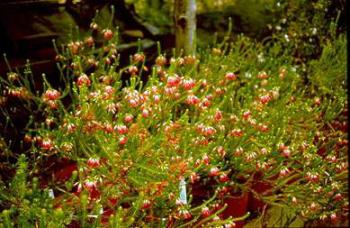Erica regia subsp . regia
Erica regia Bartl. subsp. regia
Family: Ericaceae
Common names: Elim heath, bell heath, royal heath (Eng.); belletjieheide, elimsheide (Afr.)
Introduction
Erica regia is a very popular garden plant in South Africa and features in many of the older gardening books. It is quite easy to grow and has very attractive flowers, which attract nectar-feeding birds. It is found in various colours, but the variegated white and red form is particularly sought after. This species is endangered in its natural habitat and its popularity amongst gardeners can help save it from extinction.

Description
Description
Erica regia forms a small shrub up to ± 700 mm high. It has thin woody branches and can grow to become lanky and unattractive if left to grow naturally. The bark is grey and the upper branches are covered in numerous, light green, thin, needle-like leaves. It produces a whorl of attractive, shiny tubular flowers near the ends of its branches. The flowers are either red or white or a combination of the two exhibited in the variegated form. It produces flowers throughout the year, but peak flowering is during spring (Aug.-Oct.).

It produces small capsules filled with tiny seeds that ripen about two months after flowering. Seedlings grow slowly during the first season after germination, but put on good growth from spring to autumn and may flower in the second year. Cuttings rooted in autumn (April-May) will grow actively from the following spring and may flower in the same year. It is relatively short-lived and grows for about 10 years before becoming old and straggly.
Conservation Status
Status
Endangered. Erica regia occurs on laterites in Elim fynbos between Elim and Viljoenshof. It was threatened by previous road building and is currently severely threatened by agricultural practices, road maintenance, invasive Eucalyptus cornuta (spider gum) and Acacia cyclops. The remaining population is severely fragmented.
Distribution and habitat
Distribution description
Erica regia grows on the windswept, sandy or gravelly coastal flats of the Agulhas Plain from the western Bredasdorp area to near Elim and Vijoenshof.
Derivation of name and historical aspects
History
Erica regia derives its name from the Latin word regius, meaning royal.
It was originally part of a complex of three species and three varieties that have been reduced to one species and two subspecies. The other subspecies is Erica regia subsp. mariae. The best-known variety was the variegated, white and red form known as E. regia var. variegata. This variety has been sunk into E. regia subsp. regia.

Ecology
Ecology
Erica regia subsp. regia grows on windswept coastal hills and flats in the area known as the Agulhas Plain. It prefers acidic, sandy or gravelly soils, whereas the subsp. maraie grows on tertiary limestone hills. Both are a shrublets with strong wiry branches able to withstand strong winds and support the sunbird bird pollinators that settle on them.
Uses
Use
Erica regia is a worthy garden subject and regarded as a good horticultural subject.

Growing Erica regia subsp . regia
Grow
This species is grown as a pot plant at the Kirstenbosch Nursery and also performs well in the garden. It thrives in gardens with well-drained, sandy soils in full sunlight. It can tolerate conditions ranging from windy coastal gardens to quite hot positions, as long as it gets regular watering in summer. It prefers temperatures ranging from about 10 to 25 ° C, but will cope with higher temperatures for short periods. It does not like frost.
It is propagated by rooting fresh, semi-hardwood tips or heel cuttings. Cuttings are rooted in multi-trays on heated benches under mist spray. The best time to root Erica cuttings is late summer/autumn or spring. Cuttings are rooted in bark and polystyrene, using a rooting hormone for semi-hardwood cuttings.
It germinates well from seed subjected to smoke treatment and sown in autumn.
Feed with an organic liquid or pellet fertilizer. Potting soil should be acidic, sandy and well drained. Mix a combination of equal parts composted pine bark or pine needles and river sand. A little loam (20%) may also be added. Regular pruning is recommended to keep plants well branched with a compact, neater growth habit. Pruned plants last longer.
Pests do not present a major problem, but watch out for aphids on new growth and mealy bug.
References
- Goldblatt, P. & Manning, J. 2000. Cape plants. A conspectus of the Cape flora of South Africa. Strelitzia 9. National Botanical Institute, Cape Town and Missouri Botanical Garden, USA.
- Oliver, E.G.H. & Oliver, I.M. 2002. The genus Erica (Ericaceae) in southern Africa : taxonomic notes 1. Bothalia 32: 54, 55.
- Schumann, D. & Kirsten, G. 1992. Ericas of South Africa. Fernwood Press, Vlaeberg, Cape Town.
Credits
Anthony Hitchcock
Kirstenbosch National Botanical Garden
May 2008
Plant Attributes:
Plant Type: Shrub
SA Distribution: Western Cape
Soil type: Sandy
Flowering season: Spring, Early Summer
PH: Acid
Flower colour: Red, White
Aspect: Full Sun
Gardening skill: Average
Special Features:
Horticultural zones







Rate this article
Article well written and informative
Rate this plant
Is this an interesting plant?
Login to add your Comment
Back to topNot registered yet? Click here to register.